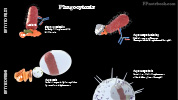II. Definitions
- Phagocyte (and Phagosome, Phagocytosis)
- Immune cells (Neutrophils and Monocytes/Macrophages) are White Blood Cells that engulf pathogens and foreign material
- Phagosomes are the membrane engulfed pathogens
- Often combined with lysis by Lysozymes
- Lysosome (and Lysozyme)
- Lysozyme-containing vacuoles produced in cellular golgi apparatus
- Lysomsomes fuse with Phagosomes, resulting in pathogen lysis (esp. Bacterial cell walls)
- Lysosomes, like Phagosomes, are found in Phagocytes (Macrophages and Neutrophils)
- Opsonin (and Opsonization)
- Proteins (e.g. Antibody, complement, C-Reactive Protein) that bind a pathogen surface, targeting it for Phagocytosis
III. Epidemiology
- Phagocytic Disorders account for 8.5% of U.S. and 12.5% of European Primary Immunodeficiency cases
IV. Physiology
- See Also Immune System
- Phagocytes (Neutrophils and Macrophages) are critical to clearing infections
- Phagosomes (Phagocytosis)
- Phagocytes such as Neutrophils (PMNs) and Macrophages attract and engulf organisms (Phagocytosis)
- Phagocytes attract organisms which in turn activate Phagocytosis
- Phagosomes are later lysed via Lysosomes (as below)
- Lysosomes
- Neutrophil's and Macrophage's (Phagocytes) golgi apparatus produce Lysosomes (vacuoles) that contain Lysozyme
- Lysosomes fuse with Phagosomes to produce phagolysosomes, degrading the engulfed organisms
- Lysosomes may also release their contents extracellularly to lyse larger targets too large to engulf
V. Complications
- Disorders of Neutrophils or Monocytes/Macrophages
- Fungal Lung Infections
- Recurrent abscesses or delayed Wound Healing
- May present with invasive infections
- Catalase positive infections (consider especially if invasive infections)
VI. Causes: Neutropenia - Decreased Absolute Neutrophil Count (ANC<500/ul)
- See Neutropenia
- Chemotherapy-related Neutropenia
-
Severe Congenital Neutropenia
- Presents in first few weeks of life
- Omphalitis
- Autoimmune Neutropenia
- Cyclic Neutropenia
- Neutrophil numbers fluctuate in 21 day cycle
VII. Causes: Decreased Neutrophil Function
- Chronic Granulomatous Disease (CGD)
- Inherited Phagocyte NADPH oxidase abnormality
- Phagocyte oxidase converts oxygen to Reactive Oxygen Intermediates (ROI)
- Without ROIs (e.g. superoxide anions), Phagocytes can not lyse and destroy engulfed Microbes
- Results in defect of PMN intracellular killing
- Typically diagnosed by age 5 years old
- May first present as omphalitis in infants
- Recurrent in Intracellular Bacterial and Fungal Infections, abscesses and Granulomas
- Examples: Pneumonia, abscesses, suppurative adenitis, gastrointestinal infections
- Inherited Phagocyte NADPH oxidase abnormality
-
Leukocyte Adhesion Deficiency (type 1)
- Adhesion molecules allow Phagocytes to adhere to vascular endothelium and migrate to infection site
- Leukocyte adhesion deficiency presents in first few weeks of life
- Delayed Umbilical Cord separation beyond 4 weeks after birth
- Omphalitis
- Other findings
- Poor Wound Healing
- Erosive perianal ulcers
- Severe Bacterial Infections (e.g. Pneumonia, chronic Skin Infections)
- Chediak-Higashi Syndrome
- Rare Autosomal Recessive disorder affecting intracellular Protein transport
- Immunodeficiency
- Neutropenia
- Neutrophil Dysfunction (defective chemotaxis and bactericidal activity)
- Natural Killer Cell dysfuncton
- Presentations
- Severe infections (often fatal in childhood)
- Lymphoma-like presentations
- Partial oculocutaneous albinism
- Hepatosplenomegaly
- Lymphadenopathy
- Blood count abnormalities
- Anemia
- Platelets deficient in dense bodies (results in Bleeding Disorder)
VIII. Resources
- National Primary Immunodeficiency Resource Center
- Immune Deficiency Foundation
IX. References
- Mahmoudi (2014) Immunology Made Ridiculously Simple, MedMaster, Miami, FL
- Cooper (2003) Am Fam Physician 68:2001-11 [PubMed]
- Reust (2013) Am Fam Physician 87(11): 773-8 [PubMed]
- Rosen (1995) N Engl J Med 333(7):431-440 [PubMed]

